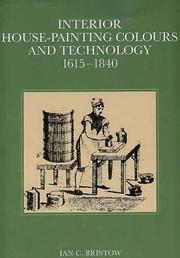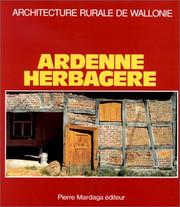| Listing 1 - 10 of 35 | << page >> |
Sort by
|

ISBN: 2870094663 9782870094662 Year: 1991 Volume: vol *108 Publisher: Liège: Mardaga,
Abstract | Keywords | Export | Availability | Bookmark
 Loading...
Loading...Choose an application
- Reference Manager
- EndNote
- RefWorks (Direct export to RefWorks)
Dès la fin du Second Empire un certain refus de la régularité se fait jour dans le milieu architectural et parmi la bourgoisie bâtisseuse. L'ouvrage confronte ces aspirations diffuses avec les Avis du Conseil des bâtiments civile. Les débats sur l'interprétation des règlements, les amendements successifs aux lois aident à retracer les variations des artifices de la monumentalité et leurs périodiques remises en question.
France --- Frankrijk --- Monumenten --- Monuments --- Public architecture --- Building laws --- Architecture --- Architecture publique --- Construction --- History --- Histoire --- Droit --- Conseil Géneral des Bâtiments Civils (Paris, France) --- Paris (France) --- Buildings, structures, etc. --- Constructions --- Patrimoine architectural --- Monumentalité --- Histoire de l'architecture --- Histoire de l'urbanisme --- Protection des bâtiments --- Protection des monuments --- Protection du patrimoine --- Paris --- Politique publique --- 711.4 <44 PARIS> --- Gemeentelijke planologie. Stadsplanning. Stedenbouw--Frankrijk--PARIS --- Architecture, Modern --- History. --- Conseil géneral des bâtiments civils (Paris, France) --- 711.4 <44 PARIS> Gemeentelijke planologie. Stadsplanning. Stedenbouw--Frankrijk--PARIS --- Conseil Géneral des Bâtiments Civils (Paris, France) --- France. --- Histoire.

ISBN: 0300038674 Year: 1996 Publisher: New Haven Yale University Press
Abstract | Keywords | Export | Availability | Bookmark
 Loading...
Loading...Choose an application
- Reference Manager
- EndNote
- RefWorks (Direct export to RefWorks)
Color in interior decoration --- House painting --- Paint --- Couleur dans la décoration d'intérieur --- Peinture en batiments --- Peinture (Produit chimique) --- History --- Histoire --- Couleur dans la décoration d'intérieur

ISBN: 9780262033794 0262033798 0262270269 143568172X 9780262270267 9781435681729 Year: 2008 Publisher: Cambridge, Mass. : MIT Press,
Abstract | Keywords | Export | Availability | Bookmark
 Loading...
Loading...Choose an application
- Reference Manager
- EndNote
- RefWorks (Direct export to RefWorks)
What happens to the landscape, to community, and to the population when vacated big box stores are turned into community centers, churches, schools, and libraries? America is becoming a container landscape of big boxes connected by highways. When a big box store upsizes to an even bigger box "supercenter" down the road, it leaves behind more than the vacant shell of a retail operation; it leaves behind a changed landscape that can't be changed back. Acres of land have been paved around it. Highway traffic comes to it; local roads end at it. With thousands of empty big box stores spread across America, these vistas have become a dominant feature of the American landscape. In Big Box Reuse, Julia Christensen shows us how ten communities have addressed this problem, turning vacated Wal-Marts and Kmarts into something else: a church, a library, a school, a medical center, a courthouse, a recreation center, a museum, or other more civic-minded structures. In each case, what was once a shopping destination becomes a center of community life. Christensen crisscrossed America identifying these projects, then photographed, videotaped, and interviewed the people involved. The first-person accounts and color photographs of Big Box Reuse reveal the hidden stories behind the transformation of these facades into gateways of community life. Whether a big box store becomes a "Senior Resource Center" or a museum devoted to Spam (the kind that comes in a can), each renovation displays a community's resourcefulness and creativity--but also raises questions about how big box buildings affect the lives of communities. What does it mean for us and for the future of America if the spaces of commerce built by a few monolithic corporations become the sites where education, medicine, religion, and culture are dispensed wholesale to the populace?
Department stores --- Stores, Retail --- Grands magasins --- Magasins --- Remodeling for other use --- Reconversion --- Retail stores --- Shops --- Stores, Department --- Commercial buildings --- Retail trade --- Shopping centers --- ARCHITECTURE/Architectural History/Modern Architecture --- Reconversion de bâtiments --- Etats-Unis --- 21e siècle
Book

ISBN: 9789492567222 Year: 2021 Publisher: Antwerpen Vlaams Architecteninstituut
Abstract | Keywords | Export | Availability | Bookmark
 Loading...
Loading...Choose an application
- Reference Manager
- EndNote
- RefWorks (Direct export to RefWorks)
Sinds 1999 heeft Vlaanderen een Bouwmeester. Die adviseert publieke opdrachtgevers met het doel de kwaliteit van de architectuur en de gebouwde omgeving te bevorderen. Een van de methodes die daartoe worden ingezet, is de Open Oproep. In een reeks essays wordt hier, vanuit verschillende invalshoeken, belicht waarom deze invloedrijke ‘wedstrijd’ net geen architectuurwedstrijd wil zijn, en tegelijk veel meer is. Baande architectuurkritiek in de jaren ’90 mee de weg voor het bouwmeesterschap en de Open Oproep? Ligt de sleutel tot kwaliteit in slimme processen? Wat is een ‘sterke’ publieke opdrachtgever in een democratisch bestel? Wat doet de Vlaamse Bouwmeester en wat heeft de Open Oproep in twintig jaar tijd teweeggebracht? Wat betekenen de afzonderlijke projecten in hun bredere ruimtelijke context? Kunnen architecten met singuliere ontwerpen tegemoetkomen aan een collectief verlangen? Hoe spoort de Open Oproep met de verbreding van de architectuurpraktijk en de evoluerende wedstrijdcultuur? Acht auteurs blikken terug op twee decennia architectuur in publieke opdracht en reiken actuele reflecties aan.
Public buildings --- Architecture --- 72.092(493) --- Team Vlaams Bouwmeester --- Architectuurwedstrijden ; België --- open competitions --- 72.01 --- 72.072 --- België --- Vlaanderen --- Architectuur (theorie) --- Architectuur (kritiek) --- Wedstrijden (architectuur) --- Bâtiments publics --- History --- Histoire --- architectuur, België --- Flanders
Book
ISBN: 9780691170572 0691170576 1400881137 9781400881130 Year: 2016 Publisher: Princeton, NJ : Princeton University Press,
Abstract | Keywords | Export | Availability | Bookmark
 Loading...
Loading...Choose an application
- Reference Manager
- EndNote
- RefWorks (Direct export to RefWorks)
The Greek military victories at Marathon, Salamis, and Plataia during the Persian Wars profoundly shaped fifth-century politics and culture. By long tradition, the victors commemorated their deliverance by dedicating thank-offerings in the sanctuaries of their gods, and the Athenians erected no fewer than ten new temples and other buildings. Because these buildings were all at some stage of construction during the political ascendency of Perikles, in the third quarter of the fifth century, modern writers refer to them collectively as the Periklean building program. In Trophies of Victory, T. Leslie Shear, Jr., who directed archaeological excavations at the Athenian Agora for more than twenty-five years, provides the first comprehensive account of the Periklean buildings as a group.This richly illustrated book examines each building in detail, including its archaeological reconstruction, architectural design, sculptural decoration, chronology, and construction history. Shear emphasizes the Parthenon's revolutionary features and how they influenced smaller contemporary temples. He examines inscriptions that show how every aspect of public works was strictly controlled by the Athenian Assembly. In the case of the buildings on the Acropolis and the Telesterion at Eleusis, he looks at accounts of their overseers, which illuminate the administration, financing, and organization of public works. Throughout, the book provides new details about how the Periklean buildings proclaimed Athenian military prowess, aggrandized the city's cults and festivals, and laid claim to its religious and cultural primacy in the Greek world.
Architecture, Ancient --- Public buildings --- Architecture --- Architecture antique --- Bâtiments publics --- Design and construction --- Conception et construction --- Athens (Greece) --- Athènes (Grèce) --- Buildings, structures, etc. --- Constructions --- Bâtiments publics --- Athènes (Grèce) --- Monuments --- Public works --- Historical monuments --- Sculpture --- Historic sites --- Memorials --- Public sculpture --- Statues --- Public works projects --- Buildings --- Construction projects --- Civil engineering --- History --- Antiquities. --- Archaeology
Book
ISBN: 9783433030226 9783433030233 Year: 2012 Publisher: Berlin : Wiley-Blackwell,
Abstract | Keywords | Export | Availability | Bookmark
 Loading...
Loading...Choose an application
- Reference Manager
- EndNote
- RefWorks (Direct export to RefWorks)
Construction de bâtiments --- Building construction --- Industrie du bâtiment --- Building industry --- Fenêtre --- Windows --- Matériau de construction --- Construction materials --- Assemblage en bois --- Joints (timber) --- Isolation --- Insulation --- Ventilation --- Contrôle de l'humidité --- Humidity control --- Propriété technologique --- technical properties --- Mur --- Walls --- Toit --- Roofs --- Bilan énergétique --- Energy balance --- Consommation d'énergie --- Energy consumption

ISBN: 0415205972 041518052X Year: 1999 Publisher: London : Routledge,
Abstract | Keywords | Export | Availability | Bookmark
 Loading...
Loading...Choose an application
- Reference Manager
- EndNote
- RefWorks (Direct export to RefWorks)
Bâtiments d'habitation --- Demeures --- Huishoudingen --- Locaux d'habitation --- Logis --- Ménages --- Residenties --- Single family houses --- Sociale archeologie --- Dwellings. --- Households. --- Social archaeology. --- Dwellings --- Households --- Social archaeology --- Archaeology --- Population --- Families --- Home economics --- Domiciles --- Homes --- Houses --- One-family houses --- Residences --- Residential buildings --- Single-family homes --- Buildings --- Architecture, Domestic --- House-raising parties --- Household ecology --- Housing --- Methodology --- Archéologie --- Architecture domestique --- Méthodologie
Book
ISBN: 9783035627237 9783035627244 303562724X 3035627231 Year: 2024 Publisher: Basel
Abstract | Keywords | Export | Availability | Bookmark
 Loading...
Loading...Choose an application
- Reference Manager
- EndNote
- RefWorks (Direct export to RefWorks)
Why does live performance continue to engage us? In a world saturated with recorded entertainment, we seek out the intimacy and immediacy of live music and theater. What is the relationship between design and the experiences, perceptions, and memories it engenders? At its best, architecture, a collection of elements - some apparent, some hidden - shapes and intensifies the process and experience of performance. Set Pieces pairs the words of leading artists and critics with details showcasing the design and inner workings from projects by Diamond Schmitt Architects for some of the world’s most remarkable performing-arts buildings. The book provides an immersive study of fifteen design elements that enhance and transform the perception of performance - and evoke experiences that surpass visual understanding. In-depth documentations of David Geffen Hall at Lincoln Center, New York, Theater an de Parade, Hertogenbosch, National Arts Centre, Ottawa and others
Centers for the performing arts --- Music-halls --- Architectural acoustics --- Salles de spectacle --- Salles de concert --- Acoustique architecturale --- Design and construction --- Conception et construction --- Diamond and Schmitt Architects --- Design and construction. --- Architecture de spectacle --- Salle polyvalente --- Salle de spectacle --- Architecture intérieure --- Typologie des bâtiments et équipements divers --- Auditorium --- Théâtre --- Theater architecture --- Diamond Schmitt Architects (Toronto, Ontario)
Multi
ISBN: 9783035625035 9783035618280 3035618283 Year: 2021 Publisher: Basel: Birkhäuser,
Abstract | Keywords | Export | Availability | Bookmark
 Loading...
Loading...Choose an application
- Reference Manager
- EndNote
- RefWorks (Direct export to RefWorks)
Adaptive reuse is a design practice where changes in the building structure go along with new programs and functions. Many concerns of the day that are the hallmark of current social discourse can equally be communicated through the vocabulary of design and reuse. Six common themes mirroring those of society in the new millennium are discernable in the current adaptive reuse practice: appropriation, ecology, equity, memory & redemption, identity and authenticity. Selected articles from the IntAR Interventions and Adaptive Reuse Journal of the last ten years speak to the social issues of the recent decade. The introductory essay positions shifting norms of working from home or remote learning in the light of their revision through adaptive reuse, for example the post-pandemic repercussions on office towers and the classroom.
Buildings --- Architecture and society. --- Architecture --- Constructions --- Architecture et société --- Remodeling for other use. --- Conservation and restoration. --- Reconversion --- Conservation et restauration --- Reconversion (architecture) --- Architecture, Modern --- Remodeling for other use --- Conservation and restoration --- Pictorial works. --- adaptive reuse --- Reconversion de bâtiments --- Reconversion de sites --- Ecologie

ISBN: 2870094906 9782870094907 Year: 1992 Volume: vol *27 Publisher: Liège: Mardaga,
Abstract | Keywords | Export | Availability | Bookmark
 Loading...
Loading...Choose an application
- Reference Manager
- EndNote
- RefWorks (Direct export to RefWorks)
Ce volume s'ajoute à la collection "Architecture rurale de Wallonie" et procède à une introduction gènèrale à l'ensemble des volumes avant d'aborder l'analyse de l'Ardenne Herbagère : celle-ci est d'abord abordée par sa géographie et son histoire, ensuite l'architecture rurale est développée. Une dialectologie sur le lexique Wallon et Germanique complète cet ouvrage.
Architecture --- Wallonia --- Bouwkunst --- Liège (province) --- Luik (provincie) --- Luxembourg (province) --- Luxemburg (provincie) --- Namen (provincie) --- Namur (province) --- Farm buildings --- Vernacular architecture --- Farmhouses --- Constructions rurales --- Architecture vernaculaire --- Maisons rurales --- Typologie rurale --- Patrimoine rural --- Habitat rural --- Architecture rurale --- Ardennes --- Construction de bâtiments --- Building construction --- Rural housing --- -Vernacular architecture --- -Architecture, Anonymous --- Architecture, Indigenous --- Architecture, Vernacular --- Folk architecture --- Indigenous architecture --- Traditional architecture --- Architecture, Rural --- Buildings, Farm --- Rural architecture --- Buildings --- Livestock --- Housing --- -Farm buildings --- Architecture, Anonymous --- Habitations rurales --- Architecture domestique --- Histoire.
| Listing 1 - 10 of 35 | << page >> |
Sort by
|

 Search
Search Feedback
Feedback About UniCat
About UniCat  Help
Help News
News